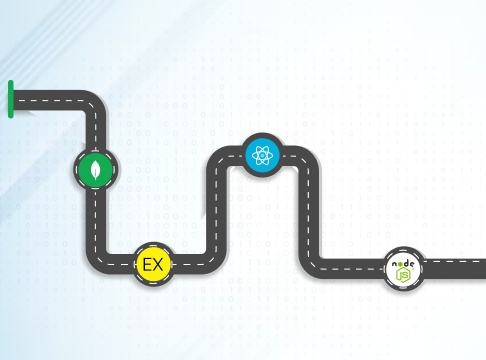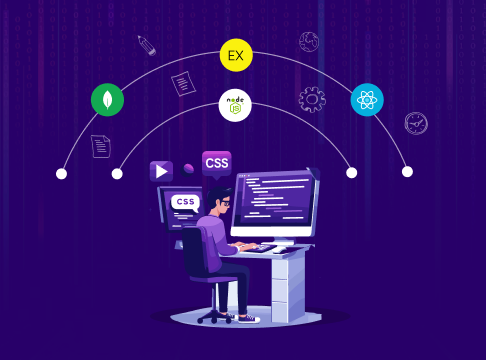The MERN stack is a suite of technologies for developing robust and scalable web applications. It consists of MongoDB, Express.js, React.js, and Node.js, hence providing a rich stack for full-stack development. This MERN Stack syllabus article will act as roadmap in your learning journey and recommend mastering those skills and technologies relevant in the field of modern web development.
MERN Stack Syllabus
Fundamentals
1. Build Your Own Static Website
- Software Development Fundamentals
- Importance of Frontend
- Fundamentals
- Syntax
- Debugging
- Tweaking Code
- HTML Basics
Getting Started HTML Images
- HTML Elements HTML Hyperlinks
- HTML Headings HTML Containers
- HTML Paragraphs HTML Lists
- HTML Button
- HTML Attributes
- CSS Basics
- CSS Rulesets CSS Units CSS Paddings
- CSS Properties CSS Box Model CSS Borders
- CSS Colors CSS Margins
- Bootstrap Components
Course Project
Create your Tourism Website using HTML5, CSS3, and Bootstrap.
2. Build Your Own Responsive Website
- Intermediate CSS
- Block vs inline elements
- CSS Selectors
- Class Selector
- CSS Specificity
- Id Selector
- CSS Inheritance
- Type Selector
- CSS Cascading
Course Project
Develop a responsive Food Munch website utilizing HTML5, CSS3, and the Bootstrap Grid System.
3. Bootstrap
- Bootstrap Grid System
- Bootstrap Utilities
- Display Utilities
- Flex Utilities
- Sizing Utilities
- Spacing Utilities
- Colors
- Bootstrap Components
Course Project
Create a responsive e-commerce site using HTML5, CSS3, and the Bootstrap Grid System.
MERN Stack Developer Course Syllabus PDF

Download
4. Programming Foundations
with Python
- Fundamentals of Programming
- Operators, Datatypes & Variables
- Strings & Numbers
- Conditional Statements
- Loops
- String Methods
- Functions
5. Introduction to Databases
- Relational Databases
- Introduction
- SQL
- Aggregation, Relationships, Join
- Querying
- ACID Properties
MERN Stack Specialization
1. Programming with Python
- Functions & Data Structures
- Recursion
- Lists
- Tuple
- Sets
- Dictionaries
- Object-Oriented Programming
- Classes & Objects in Python
- Attributes & Methods
- Inheritance & Polymorphism
- Working with Python Standard Library
- Collections
- Random
- DateTime
- Math
2. Developer Fundamentals
- Introduction to OS & Networks
- Overview of OS Concepts
- Networks & Internet
- Network Layer
- Application Layer
- Web Servers
- Working with Command Line
- Files & File System
- Managing System Packages
- Environment Variables
- Network
- Collaborating with Git
- VCS & Git Repositories
- Staging Area & Commits
3. Build Your Own Dynamic Web Application
- Introduction to JavaScript
- Data Types
- Variables
- Basic Operators
- Conditionals
- Loops
- Functions
- Arrays
- Objects
- Control Flow
- Comments
- Math Function
- DOM Manipulation
- The JavaScript Console
- Introduction to the DOM
- Select and Manipulate
- Important Selector Methods
- Manipulating Style
- Manipulating Text and Content
- Manipulating Attributes
- Local Storage
Course Project
Develop a To-Do List application using HTML5, CSS3, and JavaScript.
- Forms
- The form element
- The label element
- The input element
- The option element
- The button element
- The select element
- The text area element
- Form validations and Input
- Array Methods
- Push
- unshift
- splice
- pop
- shift
- Find
- indexOf
- Concat
- Events, Fetch & Callbacks
- How to add Event Listeners
- Callbacks
- Schedulers
- setTimeout
- clearTimeout
- setInterval
- clearInterval
- Hypertext Transfer Protocol (HTTP)
- HTTP Requests using Fetch
- HTTP Responses
- Working with JSON data
Course Project
Develop a Wikipedia Search Application
using HTML5, CSS3, JS
4. JavaScript Essentials
- Rest parameters and spread syntax
- Destructuring Arrays
- Destructuring Objects
- this
- this in methods
- window scope
- this in function declarations
- this in events
- Prototypes & ES6 Classes
- Built-in Constructor Functions
- Constructor Property
- Inheritance
- this in classes
- Asynchronous JS
- Array Methods
- String Manipulations
- trim & split Methods
- toUpperCase & toLowerCase Methods
- includes Method
5. Responsive Web Design using Flexbox
- CSS Layouting
- CSS Flexbox
- display
- flex-direction
- justify-content
- align-items
- flex-wrap
- flex-flow
- align-content
- align-self
- flex-grow
- flex-shrink
- order
- Sizing Elements
- Over flow
- Box Sizing
- Content Box
- Border Box
- CSS Media Queries
- Media Query
- Media Types
- Media Features
- Width, min-width, max-width
- Height, min-height, max-height
- Orientation
- Combining Multiple Media Features in a single Media Query.
- Logical Operators (and)
- Logical Operators (not)
- Logical Operators (,)
6. Node JS
- Introduction to NodeJS
- Node REPL
- Modules
- NPM CLI
- Aggregations
- Introduction to Express Web Application Framework
- HTTP Server
- Routes
- Handling HTTP Request
- Preparing HTTP Response
- Fundamentals of Application Building in Express
- Integration with Database
- CRUD Operations
- Error Handling
- Middlewares
- Securing APIs
- Json Web Token(JWT)
- Authentication vs Authorization
- Building Secure Web API with Express
Course Project
Create a RESTful web application, a social networking platform similar to Twitter, using ExpressJS.
7. React JS - Getting started
- Introduction to React JS
- Why React?
- Stateful + Stateless components
- Introducing JSX
- Rendering Elements
- Components and Props
- State and Lifecycle
- Handling Events
- Conditional Rendering
- Lists and Keys
- Forms
- CSS in JS
- Routing
- Query parameters
- Path parameters
- Authentication and Authorization
Course Project
Develop an E-commerce application using React JS.
8. MongoDB
- Non-Relational Databases (MongoDB)
- Introduction to MongoDB
- CRUD operations
- Querying Documents
- Aggregations
- Nested Documents
Capstone Project - Movies App
In this project, we'll create a Movies App that allows users to log in, manage their account details, browse movies including trending ones, and view detailed information about each movie.
Tools and Technologies used
Capstone Project - Tasty Kitchens
In this project, we'll develop the Tasty Kitchens Restaurant App. Users will have the ability to log in, choose recipes, add them to their cart, and place orders.
Tools and Technologies used
What are the benefits of learning the MERN Stack, and why should you follow this syllabus?
To stay current with the latest developments, candidates can follow this MERN Stack syllabus.
Here are the benefits of learning this MERN Stack syllabus:
- The MERN Stack syllabus covers both frontend and backend technologies, providing a comprehensive understanding of web development.
- Learning MongoDB, Express.js, React.js, and Node.js ensures proficiency in popular and widely-used technologies.
- Building practical applications like e-commerce sites and social networks helps in applying learned concepts to real-world scenarios.
- Proficiency in the MERN stack is highly valued in the tech industry, opening doors to various career opportunities.
- All technologies in the MERN stack have robust communities and resources, facilitating learning and problem-solving.
- The MERN stack is designed for building scalable and high-performance applications, making it ideal for modern web solutions.
- Knowledge of this stack equips developers with the ability to work on both the client and server sides, making them versatile and valuable in tech teams.
Conclusion
In Conclusion, this MERN Stack course syllabus provides a thorough understanding of modern web development technologies and prepares you for a career in building dynamic web applications. By following this syllabus, students will acquire the skills necessary to tackle full-stack development challenges and succeed in the tech industry.
Become Job-Ready as a MERN Stack Developer in 3 Simple Steps with Expert Guidance!
Explore ProgramFrequently Asked Questions
1. What is the duration of the MERN Stack Course?
The MERN Stack developer course at NxtWave typically takes around 8 months to complete. However, the duration can vary based on your learning pace and schedule. You have the flexibility to adjust the course timeline according to your progress and availability.
3. Is the MERN stack difficult?
The difficulty of learning the MERN stack depends on your background and interest in web development. For beginners, it might seem challenging initially due to the various technologies involved. However, with consistent study and practice, the complexity becomes manageable. The structured syllabus progressively builds your skills, making it approachable with dedication. Many IT and non-IT candidates have successfully cracked tech jobs through NxtWave, and with the right guidance mastering the MERN stack is achievable.
4. What should I learn for a MERN stack?
To learn effectively the MERN stack syllabus, you should focus on the following key areas:
- MongoDB: Learn about NoSQL databases, CRUD operations, querying documents, and data modeling.
- Express.js: Understand server-side development, routing, middleware, and API creation.
- React.js: Get familiar with building user interfaces, state management, components, hooks, and routing.
- Node.js: Learn server-side JavaScript, manage packages with npm, and create RESTful APIs.
5. How does the MERN Stack Syllabus help learners?
NxtWave MERN Stack course syllabus offers a comprehensive foundation in web development by teaching MongoDB, Express.js, React.js, and Node.js. It equips students with practical skills through real-world projects, preparing them for professional roles. The inclusive syllabus supports learners from diverse backgrounds, including non-IT fields, with dedicated success coach and hands-on training. This helps you achieve your career goals in the tech industry by providing live masterclasses, and continuous support to ensure successful career transitions.







.avif)



















